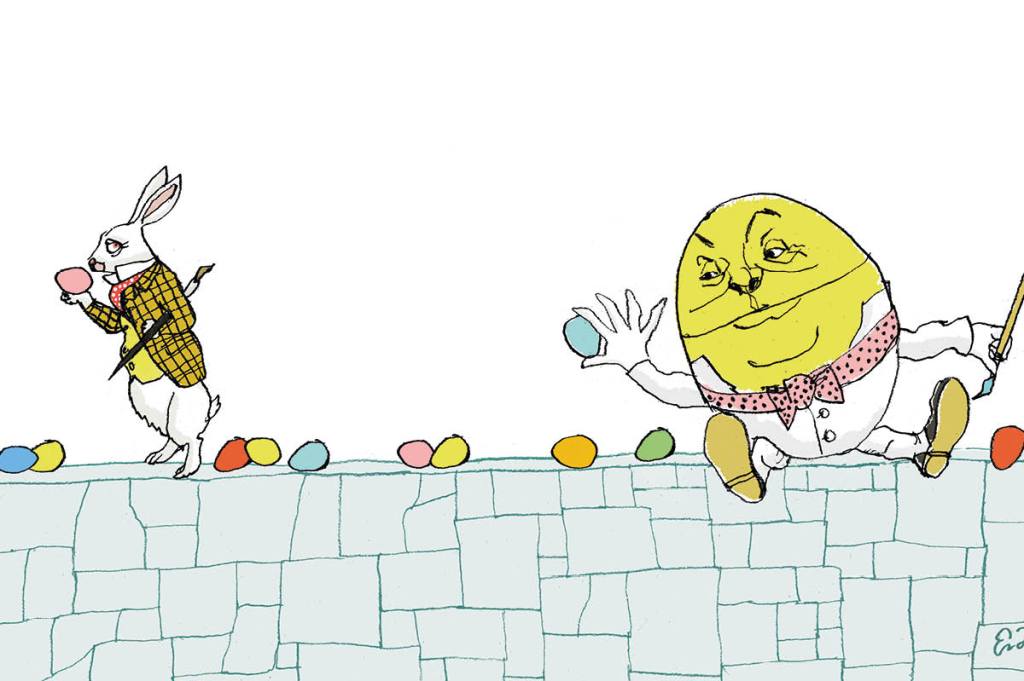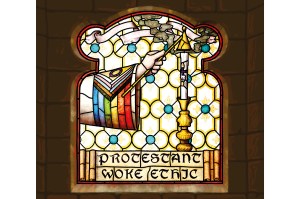Thirty feet in the air off a northern Canadian highway stands the giant Vegreville Easter egg, rotating gently in the wind. The egg is eighteen feet wide, nearly twenty-five long and designed to turn with the breeze like a weathervane. It is decorated in a traditional Ukrainian pysanka pattern with thousands of gold, black and white aluminum triangles, for the egg is an homage to the Ukrainian immigrants who settled the area long ago. It is a technical feat: the tile- cutting technology developed to produce the mosaic on the egg’s curved surface was later used to tile the exterior of the Space Shuttle.
Whatever day of the year you may spy it, it is undeniably an Easter egg. It looks up at the sky with utter innocence in every line, joyfully patterned, and it even has the element of surprise found in every good Easter egg. Most hold their surprises inside the shell, but the Vegreville egg is not meant to be opened. It is the surprise, hanging tilted and golden in the vast, austere Alberta landscape, as if newly laid by some passing roc.
Fabergé’s eggs couldn’t be more different. Yet they capture the same Easter-like essence. The Imperial Eggs were crafted for the czar to present to his wife and his mother on Easter. Each one contained a delightful secret — agreed on with the czar beforehand and revealed to no one else. The Rosebud Egg, presented by Nicholas II to his wife Alexandra, was made of gold enameled in red, set with diamond-covered Cupid’s arrows. Inside were surprises within a surprise: first, a green and yellow enamel rosebud, to remind Alexandra of the rose gardens at the palace where they spent their first Easter as newlyweds. Inside the bud was a tiny diamond-studded model of the imperial crown, along with an egg-shaped ruby pendant. Easter gifts, often eggs, are given as signs of the great, unmerited gift of salvation; and the Rosebud Egg, like redemption, is a fabulously valuable but also deeply personal gift, full of charming and affectionate detail.
How long have eggs been used to celebrate Easter? Already in second-century Mesopotamia, Christians dyed them red to honor the blood shed by the Savior. Some say the Easter egg goes back even farther, to the first century, when Christians adopted the phoenix as a symbol of the resurrected Christ. When the time comes for this mythological bird to die, it bursts into flame and regenerates itself from the egg it leaves in its ashes, like Christ rising glorious from the tomb.
;768:[300×250,336×280,320×100];0:[300×250,320×100,320×50]”]The symbol stuck and spread. The custom of decorating eggs at Easter traveled through the Byzantine empire to the Slavic nations, eventually making its way to western Europe. Medieval Lenten penance required abstinence from eggs (hence the famous Shrove Tuesday pancake tradition in which eggs and animal fat had to be eaten up before Ash Wednesday). By the time Easter arrived, both rich and poor would have an abundance of eggs on hand, not only enough to eat but to dye and to paint, to give away to children going door-to-door, and even to toss, roll — and inevitably smash — in games and contests. Edward I of England is recorded as handing out 450 chicken eggs decorated with gold leaf at Easter in 1290.
In the early eighteenth century, Louis XIV of France presented his courtiers with decorated ostrich eggs on Easter, obtained from the royal menagerie at Versailles. The Sun King is also credited with pioneering the chocolate egg, although apparently the first ones didn’t turn out as hoped (chocolate and sunshine never did mix well). A few years later, a shopkeeper in Turin had greater success, pouring melted chocolate into empty chicken-egg shells. Chocolate eggs soon became popular Easter gifts across France and Germany, though it wasn’t until 1873 that the first British chocolate egg was put on the market by J.S. Fry & Sons, two years ahead of Cadbury (with whom they would eventually merge).
Amid all these egg-shaped tokens of the feast, the simple chicken egg has retained its importance. It is the Model T, the original of all these delightful spinoffs in everything from diamonds to digestibles. It is the most authentic Easter egg of the lot, with all the symbolic connotations of the others and a few of its own.
In cuisine, eggs are peacemakers. “Make an amiable intermediary of an egg,” a nineteenth-century Frenchman by the name of des Essarts advised cooks; it “comes between the various parts [of food] to bring about difficult reconciliations.” Is it more difficult to bring about the reconciliation of oil molecules with water, effected so admirably by the emulsifying yolk, or the reconciliation of fallen human nature with God through the amiable intermediary of Christ? The latter, surely — but a repeated pattern is observable between the two events, a sort of ontological rhyme, in which tiny, unimportant egg molecules echo something so cosmically significant as the redemption of the world.
A strange analogy, you might think. But the philosopher Pythagoras, though he lived in pre-Christian times, would have found it interesting. He thought a lot about eggs. He said it was a crime to eat them, because they were microcosms of the universe. So he might not have liked people eating Easter eggs. If eating small-scale symbols of the universe is bad, how much worse to eat symbols associated with its all-powerful ruler?
;768:[300×250,336×280,320×100];0:[300×250,320×100,320×50]”]But then, living before Christ, Pythagoras never had occasion to reflect upon the notion of God becoming man and dying to open the gates of heaven. Had he known, he might have reasonably concluded that so momentous an event would change our relationship with God, and therefore our relationship to symbols of his triumph — such as Easter eggs.
As the living chicken breaks out of the egg, so the immortal Christ breaks the seal of the tomb. As eggs reconcile battling culinary elements, so Christ reconciles all things unto himself — making possible, if men have goodwill, the universal harmony Pythagoras thought he detected in the egg. Christ makes peace through the blood of his cross, portrayed on the red-dyed eggs of second-century Mesopotamia; both as to the things that are on earth — fanciful chocolates, opulent objets d’art, and many-foibled humans — and the things that are in heaven.
As for the category into which the skyscraping Vegreville egg falls… well, the jury is still out on that one. Thirty feet closer to heaven than the rest, anyway.
This article was originally published in The Spectator’s March 2024 World edition.


























Leave a Reply